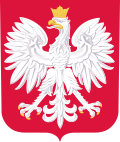2007 Polish parliamentary election
 |
|---|
Early parliamentary elections for both houses of parliament (Sejm and Senat) were held in Poland on 21 October 2007 after the Sejm voted to dissolve itself on 7 September 2007. The election therefore took place 2 years earlier than the maximum 4 year tenure of the Polish Parliament, the previous elections having been in September, 2005. All parties voted for the dissolution, except the 2 minor partners in the until-recently governing coalition: the League of Polish Families and Self-Defense of the Republic of Poland.[1] Parties competed for all 460 seats in the Sejm and all 100 seats in the Senate. The election was a contest between the two largest parties, the ruling Law and Justice party and the largest opposition group, the Civic Platform, for first place, with the Left and Democrats coalition group likely to come in third. The other parties, most notably League of the Republic’s Right (formed from a coalition of the League of Polish Families, Real Politics Union and some other right-wing groups), the Self-Defense of the Republic of Poland and the Polish People's Party, will be fighting hard to overcome the 5% electoral threshold for election to the Sejm.[2]
Contesting parties
Only 7 parties are contesting all 41 electoral districts for the Sejm nationwide. These are:
- Law and Justice (PiS)
- Civic Platform (PO)
- Left and Democrats (LiD)
- Polish People's Party (PSL)
- League of Polish Families (LPR)
- Self-Defense of the Republic of Poland (SRP)
- Polish Labour Party (PPP)
Three other parties managed to register their candidates in at least one district. These are:
- Women's Party (PK) — 7 districts;
- Patriotic Self-Defense (SOP) — one district;
- German Minority (MN) — one district;
On 26 September 2007, the leader of another registered party, the National Party of Retirees and Pensioners, Tomasz Mamiński announced his party's withdrawal from the campaign, stating as the cause that Polish electoral law gives smaller parties no chance, and that media favour bigger ones.[3]
Although only the above mentioned 10 parties are openly contesting elections to the Sejm, many more parties will compete in the lower house elections. It is common practice in Polish elections for many smaller parties to register their candidates on the electoral committee lists of the bigger parties contesting the election. Therefore:
- on LPR's lists are members of Real Politics Union and Right of the Republic;
- on PiS's lists are members of Polish People's Party "Piast", National People's Movement, Patriotic Movement, Centre Party and Christian-National Union;
- on SRP's lists are members of Piotr Ikonowicz's New Left party, Leszek Miller's Polish Left party and Zygmunt Wrzodak's National Congress of Poland;
- on LiD's lists are members of Democratic Left Alliance, Social Democracy of Poland, Democratic Party - demokraci.pl, Labour Union, REASON of Polish Left, Democratic Left Party and Polish Socialist Party;
- on PPP's lists are members of Communist Party of Poland, Union of the Left, Polish Socialist Party, REASON of Polish Left, Movement for Unemployed Protection, National Forum of Retirees and Pensioners and Green Party.[4]
There are 29 political groupings contesting the elections to the Senate.
Preliminary Results
According to exit polls, current governing party, Law and Justice (PiS), lost the election to the Civic Platform (PO). Prime Minister and PiS leader Jarosław Kaczyński will step down from office after first meeting of the new Sejm, and PO leader, Donald Tusk, is expected to become the next Prime Minister of Poland.
Detailed unofficial results after 90,8% of votes processed[5]:
- Civic Platform (conservative liberal) - 41.64% (208 seats)
- Law and Justice (populist, national conservative) - 32.04% (164 seats)
- Left and Democrats (centrist, center-left, social democratic) - 13.17% (52 seats)
- Polish People's Party (agrarian) - 8.83% (35 seats)
- German Minority - 0.26% (1 seats)
Following parties will very probably not enter the new Sejm, because they failed to reach the 5% votes threshold:
- League of Polish Families (populist, far-right) - 1.54%
- Self-Defense of the Republic of Poland (populist, far-left, agrarian) - 1.28%
- Polish Labour Party (far-left, socialist) - 1.01%
- Women's Party (far-left, feminist) - 0.26%
Civic Platform and Polish People's Party are likely to form the new government with majority of seats.
Results
Seats share forecast for Committees is based on announcement of National Electoral Commission after 25235 (99.05%) polling wards transmitted the results.[6] Template:Polish parliamentary election, 2007
Notes
- ^ http://news.bbc.co.uk/2/hi/europe/6984543.stm
- ^ http://www.eux.tv/article.aspx?articleId=13797
- ^ http://www.tvn24.pl/-1,1522707,wiadomosc.html
- ^ http://wybory2007.pkw.gov.pl/SJM/EN/KOMITETY/dsk.htm
- ^ http://wiadomosci.gazeta.pl/Wiadomosci/1,80269,4600395.html
- ^ http://wybory2007.pkw.gov.pl/SJM/EN/WYN/M/index.htm
See also
- Elections in 2007
- Senate - the upper house
- Sejm - the lower house
